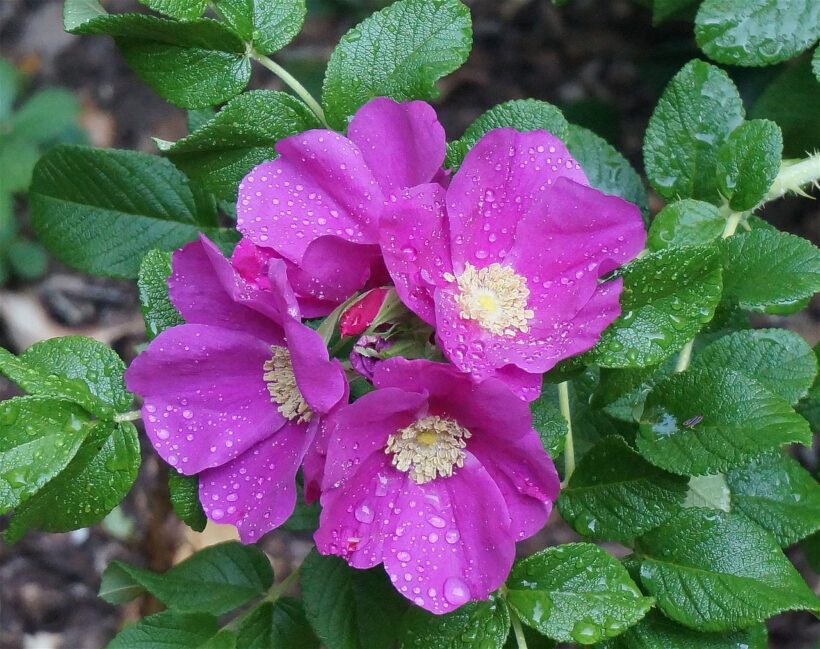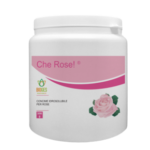
Rosa rugosa: how to grow it?
Rosa rugosa, a shrub with irresistible charm
The rosa rugosa (or japanese rose, or rugosa rose) is a rose native to East Asia, later introduced to other parts of the world, including Europe and North America. This rose variety has become particularly popular for its beauty and resistance to many diseases. Its rigorous growth makes it suitable for creating flowering hedges in gardens and parks. There are several cultivars of the rugosa rose, and the characteristics may differ somewhat between varieties. Among those most appreciated for their intense and fragrant blooms is the Alba rugose rose. The large, white petals of this rose variety add a touch of elegance to the garden.
Rosa rugosa – characteristics
 Rugose rose is a shrub that adapts easily to any adverse conditions. In particular, it grows well in various soils and even when climatic conditions are particularly adverse. Thus, it grows well in various regions, even in coastal areas, as it tolerates salinity well. Due to its characteristic resistance to many diseases, this plant is easy to cultivate in comparison to other varieties. The leaves of this plant are thick and wrinkled and have an oval or round shape with serrated margins. Depending on the variety, the flower petals can be pink, white or red. They can appear singly or in groups of flowers.
Rugose rose is a shrub that adapts easily to any adverse conditions. In particular, it grows well in various soils and even when climatic conditions are particularly adverse. Thus, it grows well in various regions, even in coastal areas, as it tolerates salinity well. Due to its characteristic resistance to many diseases, this plant is easy to cultivate in comparison to other varieties. The leaves of this plant are thick and wrinkled and have an oval or round shape with serrated margins. Depending on the variety, the flower petals can be pink, white or red. They can appear singly or in groups of flowers.
How to care for the rosa rugosa?
Thanks to its resistance to many diseases, this plant is easy to grow in comparison to other varieties. However, some care is necessary to ensure its health and beauty. To have garden roses always in perfect shape, we advise you to follow our expert’s advice. In particular, Doctor Bioges recommends regular watering, especially during dry periods, avoiding water stagnation. During irrigation, it is preferable to avoid wetting the leaves in order to reduce the risk of fungal diseases. It is necessary to inspect the rose plant regularly for signs of pests or diseases and to intervene promptly. If you live in areas with harsh winters, it is advisable to protect the base of the plant with a layer of mulch. This will insulate the roots of the plant from the cold and reduce the risk of damage.
When to plant the rosa rugosa?
For this species of shrub, all the general principles applicable to rose care are valid. In particular, one should plant bare root roses during the vegetative rest period and possibly away from periods of intense cold. Whereas roses grown in loam can be planted at any time of the year without problems. These two planting materials are priced differently. Bare-root roses cost much less and are characterised by a lower probability of rooting. On the other hand, those in loam are a safer material and give better results during cultivation. Doctor Bioges advises those with no experience in gardening to buy rugose roses in loaf soil if they want to grow only a few plant. Conversely, for gardeners who want for example to create a hedge of roses, it is preferable to buy bare-root roses.
How and when to prune the rugosa rose?

Japanese rose pruning is an important step to keep the plant healthy, encourage flowering and control its size. Pruning is a delicate procedure to only do correctly and at certain times of the year. In particular, spring, before the plant starts to bud, is the best period. It is best to remove dead branches, and the ones with diseases or damages. One must proceed by cutting at the base using sharp pruning shears. After pruning, it is advisable to use a natural healer, such as a Propolis formulation. The product not only heals the plant’s wounds, but also protects it from fungal and parasitic attack.
How to take rugosa rose cuttings?
 The rugose rose has a good chance of propagation through rose cuttings. Doctor Bioges recommends following his guidelines on how to take rose cuttings. First, a healthy cutting must be selected from a strong, sturdy mother plant. Then cut with sharp scissors below a node (at the point where the leaves join the branch). Proceed to remove the leaves from the lower part of the cutting, leaving only a couple on top. If you wish to accelerate the rooting process, we recommend using the liquid rooting agent Radikal Sprinter. This formulation can also be used for propagating plants by layering and for overcoming repotting stress.
The rugose rose has a good chance of propagation through rose cuttings. Doctor Bioges recommends following his guidelines on how to take rose cuttings. First, a healthy cutting must be selected from a strong, sturdy mother plant. Then cut with sharp scissors below a node (at the point where the leaves join the branch). Proceed to remove the leaves from the lower part of the cutting, leaving only a couple on top. If you wish to accelerate the rooting process, we recommend using the liquid rooting agent Radikal Sprinter. This formulation can also be used for propagating plants by layering and for overcoming repotting stress.
Fungal diseases, pests and insects that can attack rosa rugosa
Like all plants, pests and insects, but also fungal diseases, can attack the rugose rose. Therefore, timely action must be taken in order to avoid serious damage to the plant. In particular, it can be subject to attack by aphids and scale insects, which attach themselves to the leaves and branches and feed on their sap, causing weakening of the plant and leaf deformities. Other pests that can attack rugose roses are beetles, whiteflies and red spider mites. They also usually suffer from fungal diseases such as powdery mildew and rust. When facing such problems, it is advisable to immediately remove and destroy branches and leaves with pests and diseases. In addition, if the infestation is severe, the use of an insecticide or fungicide is appropriate.
When to fertilise roses?
 Fertilise roses regularly is essential to promote the healthy growth of the plant and to stimulate flower production. It is advisable to buy a rose fertiliser and use it at least twice a year: before spring starts and in early summer. The advice is to use a water-soluble fertiliser to distribute around the base of the plant, avoiding direct contact with the stem and roots. If you notice excessive leaf growth to the detriment of the flowers, you should reduce the nitrogen supply to encourage more flowering. Doctor Bioges recommends following the instructions on the fertiliser package. Finally, if you are in doubt, you could also consult a gardener for more advice on cultivating roses.
Fertilise roses regularly is essential to promote the healthy growth of the plant and to stimulate flower production. It is advisable to buy a rose fertiliser and use it at least twice a year: before spring starts and in early summer. The advice is to use a water-soluble fertiliser to distribute around the base of the plant, avoiding direct contact with the stem and roots. If you notice excessive leaf growth to the detriment of the flowers, you should reduce the nitrogen supply to encourage more flowering. Doctor Bioges recommends following the instructions on the fertiliser package. Finally, if you are in doubt, you could also consult a gardener for more advice on cultivating roses.
Stay up-to-date with our latest gardening news!
If you have questions, the Bioges team is always ready to assist you. You can contact us directly on our social networks or by sending an e-mail to info@biogesandco.com



